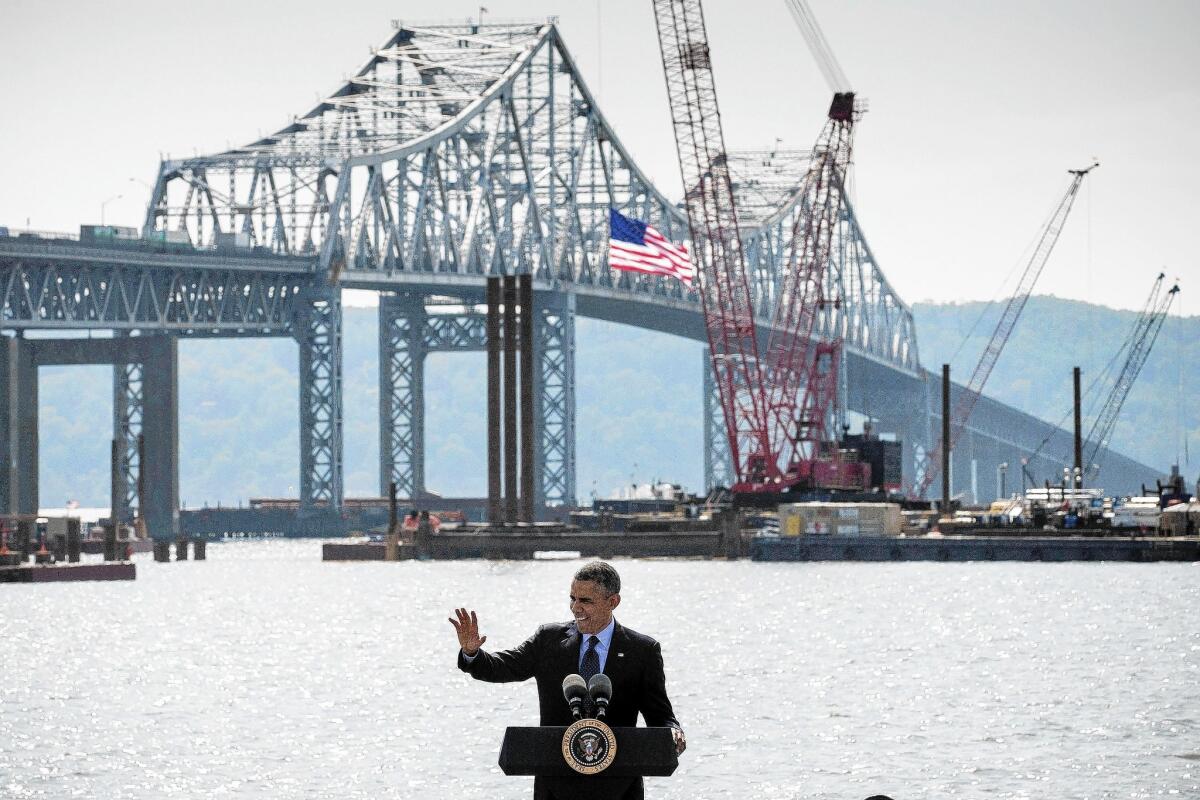Obama’s focus turns to narrower achievements

- Share via
Reporting from Washington — President Obama stood on the banks of the Hudson River last week, dwarfed by the mammoth new eight-lane, cable-stayed bridge arising from its waters. Such mighty projects are a sign of strength, he said, and declared: “A great nation does these things.”
Yet as he marveled at the new bridge and assailed his opponents for not backing more big initiatives, Obama had only the tiniest announcement to deliver. His administration will improve interagency coordination on federal permits, he said, and has beefed up a website that tracks progress on construction projects.
The moment captured a persistent predicament for the president who was elected six years ago promising hope and change: Now, increasingly, he talks about nuts and bolts. As he tries to show he can take action without help from Republicans in Congress, Obama has found himself touting minor tweaks to bureaucratic processes.
To be sure, every second-term president complains about his waning influence on the domestic front. Obama’s predecessor, George W. Bush, opened with ambitious intentions to overhaul Social Security but ended with that and most of his domestic plan in tatters.
White House advisors argue that although Obama’s individual announcements may be small, collectively they help the president and Democrats present a clear contrast with Republicans. Polls show that his job approval has started to improve, possibly indicating the strategy is having an effect.
Nonetheless, Obama does face strict limits on what he can accomplish this year, and some of the limits are the result of crosscurrents in his own party.
For the sake of his legacy and agenda, he has embarked on what he calls a “year of action,” promising aggressive directives on top priorities, including climate change, economic development and education. At the same time, with competitive Senate races in red-leaning states already heating up, some allies and Democrats are sending the opposite message to the White House. Less, they say, is more.
This week, immigration activists urged the president to be cautious about the changes he makes to the Department of Homeland Security’s deportation policies. Though they’ve long wanted the administration to slow the pace of deportations, they don’t want the new policies to alienate Republicans and drive them away from an elusive compromise on a comprehensive immigration overhaul.
The White House also is under pressure from some Democrats in coal-friendly states to tread lightly in its proposed new regulations for carbon emissions from power plants, due out next month. When the administration decided not to take quick action on whether to approve the Keystone XL oil pipeline from Alberta, Canada, to Nebraska, some environmental activists breathed a sigh of relief.
The deportation review and the carbon regulations are two pieces of Obama’s “pen and phone” strategy with the biggest impact. There are others that could leave a lasting imprint. When the White House released a recent status check on “year of action” activity, it pointed to other highlights: $1 billion in private sector commitment to help bring wireless and broadband Internet service to 15,000 schools and a $100-million competition to support innovation in high schools. It touted its plans to rethink job training programs and argued that its push to increase the minimum wage had “spurred” states to act.
But it also included initiatives that previously would have been unlikely to receive much presidential attention. In February, the White House announced a series of conferences on exporting goods from rural America and an executive order mandating the “timely completion” of a computer system to track trade data.
When Obama recently touted his work on climate change, he came armed with corporate promises to increase the use of renewable energy. But the new federal efforts he mentioned were limited. Among them was news that the White House had installed solar panels on its roof and completed new regulations for energy efficiency — one for walk-in refrigerators, the other for escalators and conveyor belts.
The president’s advisors say such details aren’t governmental minutiae, but concrete examples of the kind of change that anchors the president’s big ideas.
When Obama went to the site of the old Tappan Zee Bridge in Tarrytown, N.Y., and talked about cutting red tape to speed the construction of the new bridge, his underlying message was about Republicans refusing to fund large-scale projects and blocking economic progress, said Joel Benenson, the president’s chief pollster and a senior strategist since the beginning of Obama’s 2008 campaign.
The president’s remarks are really about his philosophy, he argued.
“He talks about pay equity, minimum wage, our need to invest in infrastructure,” said Benenson. “It shows the fundamental philosophical difference.
“That’s a contrast that is going to be driven over and over again between now and November,” he said. “The choice is between President Obama and Democrats, who stand for the economic lives of hardworking Americans, and Republicans, who have abandoned them almost every day.”
On one level, if any of these announcements makes a lasting impression on voters, it may be a result of the picture, not the words. The White House is mindful that the image of the president standing by cranes erecting the nearly $4-billion bridge is far more memorable than what he says about the new infrastructure “dashboard” website.
The president’s team thinks the message is breaking through, and is cheered by a small uptick in Obama’s approval rating, which sank throughout 2013 and steepened after the troubled rollout of HealthCare.gov, the government’s health insurance portal. The percentage of voters who disapprove of the way Obama is handling his job is also shrinking, according to Gallup — not dramatically, but in a solid trend that heartens Democrats running for reelection in November.
Still, many are keeping their distance, leaving the president to simply raise money for congressional campaigns and avoid actions that could cause problems for them.
The best thing he can do is create good “background music” for his party, said James Thurber, director of the Center for Congressional and Presidential Studies at American University.
“He’s trying to set a general tone of, ‘We care about the middle class, we care about the gap between the rich and the poor,’” said Thurber. “He’s providing the music, like an orchestra, and letting each of the singers do their own thing.”
Obama himself noted that if he had any hope of getting out of the weeds, he would need allies on Capitol Hill. “I can do some things administratively; we can do more if we’ve got folks who are serious in Congress,” Obama told some big-dollar donors at a fundraiser after his bridge event.
At the very least, the president avoids the appearance of sitting at the White House and twiddling his thumbs. On Friday, he made phone calls to world leaders, each one announced in a separate news release, and met with families of the plaintiffs in the historic Brown vs. Board of Education court case to mark its 60th anniversary.
He also took time for a quasi-public lunch, for which the White House released the names of his guests — four construction workers who joined him and Vice President Joe Biden for burgers at a Shake Shack.
kathleen.hennessey@latimes.com
More to Read
Sign up for Essential California
The most important California stories and recommendations in your inbox every morning.
You may occasionally receive promotional content from the Los Angeles Times.















